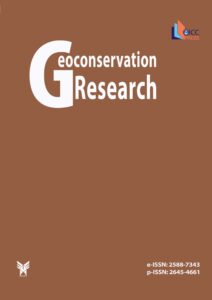Original Article
Oligocene Trace Fossil Geoconservation and Geoheritage: On the Mammals Tracks of the Luberon UNESCO Global Geopark
Authors
-
Pauline Coster
*
 1
1
- Stephane Legal 1
Abstract
Trace fossils represent an important component of the Earth’s heritage that provide important keys for learning about the diversity and evolution of life and environments through time. They represent a rich and fragile geoheritage that requires special geoconservation measures.
The Saignon tracksite, yielding thousands of tracks attributed to mammals, is located in the heart of the Luberon UNESCO Global Geopark. A conservation approach for this exceptional site is developed while promoting education, public awareness raising, geotourism and the sustainable development of Luberon through the valorization of its natural heritage.
Keywords
Main Subjects
References
Agnew N & Demas M (2016). Fossil tracks and trackways: The dilemmas of preservation. Journal of Paleontological Techniques. 15: 3–21.
Apostolescu V & Guernet C (1992). Les ostracodes oligocènes de la région Forcalquier-Manosque (Bassin continental d'Apt, Haute-Provence). Revue de Micropaléontologie. 35: 91–115.
Astibia H, Pereda Suberbiola X, Payros A, Murelaga X, Berreteaga A, Baceta JI & Badiola A (2007). Bird and mammal footprints from the tertiary of Navarre (Western Pyrenees). Ichnos. 14: 175–184.
Bennett MR, Falkingham P, Morse SA, Bates K & Crompton RH (2013). Preserving the impossible: Conservation of soft sediment hominin footprint sites and strategies for three-dimensional digital data capture. Plos One. 8: e60755.
Casanovas-Cladellas ML & Santafé-Llopis JV (1974). Nota sobre el hallazgo de icnitas de mamiferos en el Terciaro catalan. Acta Geologica Hispanica. 9: 45–49.
Casanovas-Cladellas ML & Santafé-Llopis JV (1982). Icnofauna oligocena de agramunt (Lerida, Espana). Acta Geologica Hispanica. 17: 113–119.
Cavelier C, Alabouvette B, Amberger G, Cautru J-P, Charolais J, Chateauneuf JJ, Crochet JY, Campredon R, Debeglia N, Durand JP, Feist-Castel M, Freytet P, Gannat E, Gaudant J, Giannerini G, Godinot M, Hartenberger JL, Hugueney M, Kerckhove C, Lefavrais-Raymond A, Legendre S, Lespinasse P, Magne J, Nury D, Pairis JL, Plaziat JC, Remy JA, Schlund JM, Sige B, Sittler C, Sudre J, Trauth N, Truc G, Valleron MM, Vianey-Liaud M & Villate J (1984). Paléogène. In Debrand-Passard S, Courbouleix S & Liehardt M-J (eds), Synthèse géologique du Sud-Est de la France (pp. 389-468). Orléans: BRGM.
Costeur L, Balme C & Legal S (2009). Early Oligocene mammal tracks from southeastern France. Ichnos. 16: 257–267.
Demathieu G, Ginsburg L, Guerin C & Truc G (1984). Étude paléontologique, ichnologique et paléoécologique du gisement oligocène de Saignon (Bassin d'Apt, Vaucluse). Bulletin du Muséum National d'Histoire Naturelle. 6: 153–183.
Ellenberger P (1980). Sur les empreintes de pas des gros mammifères de l’Eocène supérieur de Guarrigues-Ste-Eulalie (Gard). Palaeovertebrata, Mémoire Jubilé R. Lavocat: 37–78.
Fabre E (2020). Étude paléoichnologique et paléoécologique du site à empreintes de pas de vertébrés oligocènes de Saignon (Vaucluse, SE France). Mémoire de Diplôme d’études approfondies, Université de Rennes 1.
Feibel CS, Agnew N, Latimer B, Demas M, Marshall F, Waane SA & Schmid P (1996). The Laetoli hominid footprints – a preliminary report on the conservation and scientific restudy. Evolutionary Anthropology. 4: 149–154.
Feist M (1977). Étude floristique et biostratigraphique des Charophytes dans les séries du Paléogène de Provence. Géologie Méditerranéenne. 4: 109–138.
Hippolyte JC, Angelier J, Bergerat F, Nury D & Guieu G (1993). Tectonic-stratigraphic record of paleostress time changes in the Oligocene basins of the Provence, southern France. Tectonophysics. 226: 15-35.
Marty D, Cavin L, Hug WA, Jordan P, Lockley MG & Meyer CA (2004). The protection, conservation and sustainable use of the Courtedoux dinosaur tracksite, Canton Jura, Switzerland. Revue de Paléobiologie. 9: 39–49.
Marty D, Strasser A & Meyer CA (2009). Formation and taphonomy of human footprints in microbial mats of present-day tidal-flat environments: implications for the study of fossil footprints. Ichnos. 16: 127–142.
Mesci BL, Erkman AC & Özkurt SO (2019). Primary report of first documentation of mammal footprints from the late Oligocene in the Sivas Basin, Turkey. Turkish Journal of Earth Sciences. 28: 822–833.
Ménouret B (2014). Gisements paléontologiques à mammifères ou empreintes de pas de mammifères du Parc naturel régional du Luberon. Courrier scientifique du Parc naturel régional du Luberon et de la Réserve de Biosphère Luberon-Lure. 12: 56–74.
Murelaga X, Baceta JI, Astibia H, Badiola A & Pereda Suberbiola X (2000). Icnitas de perisodactilos en el oligoceno de Navarra: Posicion estratigrafica y sistematica. Stratigraphical and systematical position of perissodactyl footprints from the Oligocene of Navarre. Geogaceta. 27: 15–18.
Nury D & Conesa G (2000). Interprétation sédimentologique et stratigraphique du site à empreintes de pas de vertébrés de Saignon (Vaucluse). Courrier scientifique du Parc naturel régional du Luberon et de la Réserve de Biosphère Luberon-Lure. 4: 90–109.
Page KN (2018). Fossils, heritage and conservation: Managing demands on a precious resource. Geoheritage. 24: 107–128.
Santamaria R, Lopez G & Casanovas-Cladellas ML (1989). Nuevos yacimientos con icnitas de mamiferos del Oligoceno de los alrededores de Agramunt (Lleida, Espana). Paleontologia i Evolucio. 23: 141–152.
Santos VF, da Silva CM & Rodrigues LA (2008). Dinosaur track sites from Portugal: Scientific and cultural significance. Oryctos. 8: 77–88.
Szarvas I (2007). Case study of the Ipolytarnoc track site, Hungary. New Mexico Museum of Natural History and Science Bulletin. 42: 303–307.



